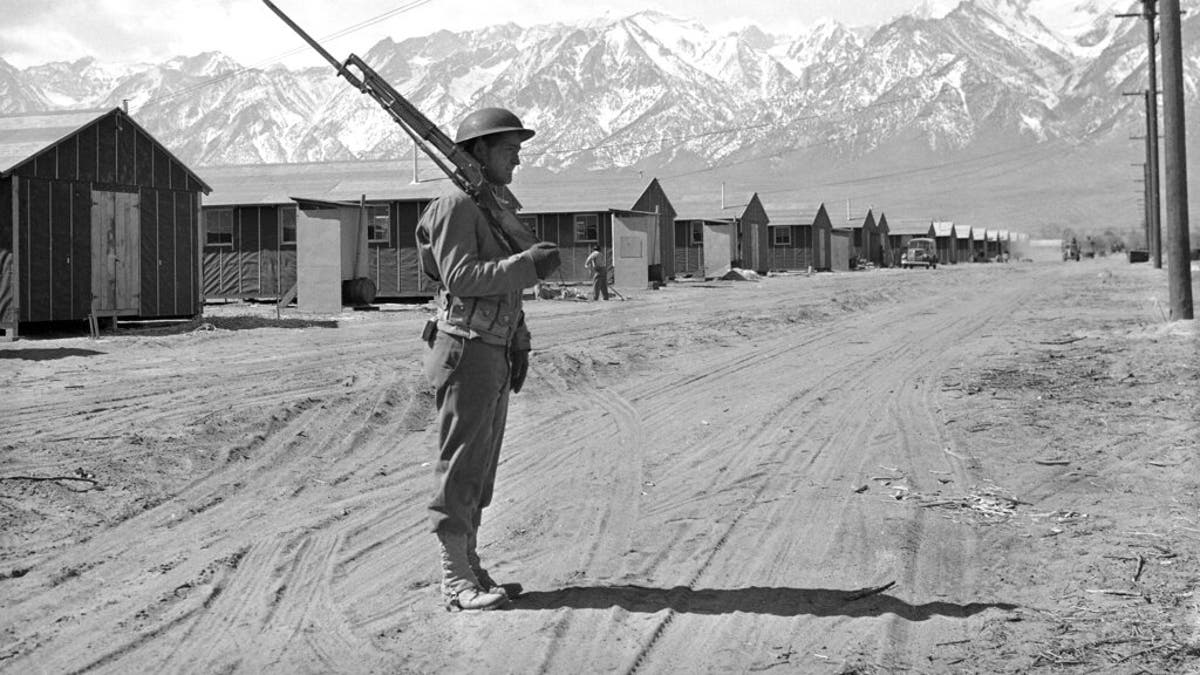Fox News Flash top headlines for Oct. 24
Fox News Flash top headlines for Oct. 24 are here. Check out what's clicking on Foxnews.com
Authorities are investigating whether a skeleton found in California’s Sierra Nevada mountains earlier this month represents the remains of a Japanese-American man who was imprisoned in the internment camps at Manzanar during World War II.
In the final days of the war, Giichi Matsumura – that's the suspected ID behind the remains – set out with other men from the camp on a trip to the mountains. From there, he went off on his own and got caught in a summer snowstorm.

An American soldier guards a Japanese internment camp at Manzanar, Calif. (AP)
A hiker found the body weeks later amid boulders. He was laid to rest in a spot marked only by a small stack of granite slabs.
Over the years, as the story faded along with memories, the location of Matsumura's burial in the remote landscape was lost. Now, 74 years later, his remains may have finally been found, though.
The Inyo County Sheriff's Office told The Associated Press that investigators will conduct DNA tests on the bones. If the suspicions prove correct, Matsumura will have the distinction of having been lost and found twice.
His fate is a footnote to one of the darkest chapters in U.S. history, when more than 110,000 Japanese-Americans were deemed a security risk as the U.S. and Japan waged war. The Americans were herded into prison camps in remote locations amid fears about their loyalties.
Matsumura was among about 10,000 who ended up in Manzanar, about 185 miles north of Los Angeles in a place blazing hot in summer and frigid in winter.

In this Oct. 16 photo released by the California Highway Patrol, their H-80 helicopter sits near where a human skeleton was discovered on Mount Williamson. (California Highway Patrol via AP)
Unlike in the early days of the internment camps, there was no security on July 29, 1945, when Matsumura tagged along with six to 10 fishermen on a trek to a chain of lakes beneath the mammoth peak.
On the night the snowstorm blew in, the other fishermen took shelter in a cave. When the weather cleared, they couldn't find Matsumura. Two search parties spent several days looking for him but found only his sweater.
A month later, Mary DeDecker, a botanist and avid hiker, spotted the remains and reported it to authorities. A burial party from the camp ascended the mountain, located the body and buried it.
Matsumura left behind a wife, a daughter, three sons, a brother and his father, all living in the camp. It's unclear if any family members attended the burial or ever returned to the site.
Over the years, rumors surfaced of grave robbers. Hikers have written on blogs about searching for the site.
WALTER BOREMAN: 75 YEARS AGO, BRAVE AMERICAN TROOPS HONORED A US COMMITMENT AND CHANGED HISTORY
Earlier this month, Tyler Hofer, a hiker from San Diego, got off course on his way toward the summit of Mount Williamson and spotted a bone near a lake. He and a friend moved rocks away to reveal a skull and an entire skeleton with the arms crossed in what seemed to be a burial pose.
CLICK HERE TO GET THE FOX NEWS APP
If the bones turn out to be those of his grandfather, said Wayne Matsumura, there is already a place for them: In a corner of Woodlawn Cemetery in Santa Monica, where his grandmother is buried, a black granite headstone bears her name and that of her long-lost husband
The Associated Press contributed to this report.


